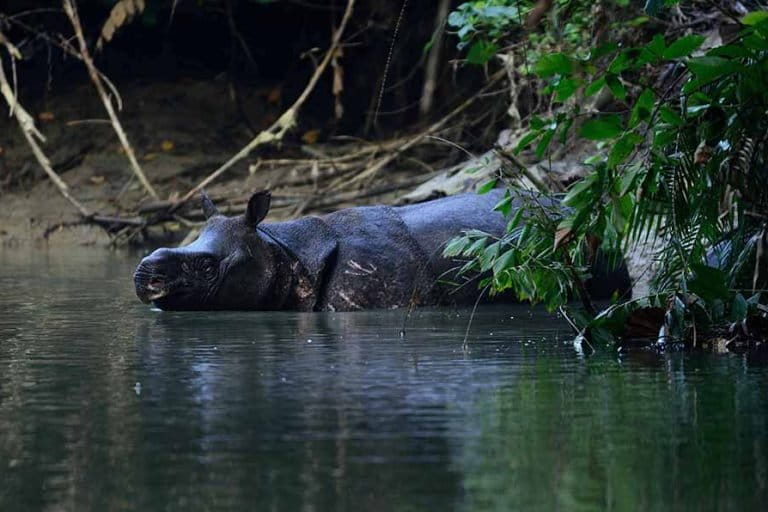- Only around 60 Javan rhinoceroses are believed to remain, all of them in Indonesia’s Ujung Kulon National Park.
- Authorities have caught dozens of people hunting, gathering forest products and planting crops in the park, including the recent arrest of 13 people in core rhino habitat.
- Despite the challenges, the population is believed to be stable and calves continue to be born.
With an estimated population of around 60 individuals, the Javan rhino (Rhinoceros sondaicus) is among the world’s most Critically Endangered species. Once spread across much of southern Asia — from northeastern India to Vietnam, and south to Sumatra and Java in Indonesia — the species is now known to survive in just one habitat: Ujung Kulon National Park at the westernmost tip of Java.
Set aside as a protected area since the Dutch colonial era, Ujung Kulon has long been a safe haven and stronghold for Javan rhinos. But conservationists say this last habitat faces a number of threats, including incursions by humans.
Dozens of people have been caught conducting illegal activities in the park’s core zone and jungles, Ujung Kulon National Park Head Mamat Rahmat told Mongabay’s Indonesian sister site.
These activities include hunting birds and lesser mouse-deer (Tragulus kanchil); gathering honey, wood and jernang (a red palm resin used for making dye); and even planting rice and other crops.

Evidence seized by authorities demonstrates that 13 people were gathering jernang in known Javan rhino habitat earlier this year, Rahmat said. “This kind of activity is indeed prone to recurring. The park authorities took repressive measures to create a deterrent effect.”
The case has been sent to the Pandeglang Regency Prosecutor’s office, based on an incident report written July 8, 2017. Authorities also allege there are indications that people have entered rhino habitat with the intention of hunting, including at least one person Rahmat said was suspected of being a “financier.”
Muhammad Waladi Isnan, Java area protection manager for the Indonesian Rhino Foundation (YABI) said human incursions into wildlife areas disturb animals living there and can be detrimental to conservation efforts, regardless of whether hunting occurs. Experts fear such illegal activities could hamper activities aimed at increasing the number of Javan rhinos.
The park’s research station has been working on surveying the population by camera trap since 2011. During nine months of monitoring in 2011, the project obtained 427 video clips of Javan rhinos in their natural habitat. Based on their specific physical features, researchers identified 35 individuals in these clips – 22 males and 13 females. A more expansive survey carried out in 2013, which obtained 1,660 video clips of rhinos, allowed researchers to establish a minimum population of 58 individuals — 35 males and 23 females.
That population included at least eight calves, indicating that Ujung Kulon’s rhinos are breeding. However, the numbers fall short of a target, set in 2007, of raising the population to 70-80 individuals by 2015. Some conservationists believe the park may not be able to support a larger population.

The long-term fortunes of the park’s rhinos — and by extension, the species as a whole — are also threatened by the prospect of disease or natural disaster. A study published in April 2017 found that a tsunami the size of the 2006 Java tsunami would put most, if not all, of the park’s rhinos in danger of drowning. Given Ujung Kulon’s position in the shadow of an active volcano, as well as the area’s history of seismic activity, such disasters are an ever-present possibility.
Plans to establish a second site for Javan rhinos have long been discussed, and efforts are also underway to expand suitable habitat within Ujung Kulon.
In the meantime, park authorities are working to ensure the current rhino range remains as secure as possible. Four Rhino Protection Units, conducted by park authorities in cooperation with conservation NGOs, regularly patrol the area. In addition, community members participate in joint patrols four times a year.
YABI’s Isnan also points to the importance of ensuring that people living near the park are living in sustainable social and economic conditions. “So, in the process of conservation, people can be involved and engaged,” he said.
This story was reported by Mongabay’s Indonesia team and was first published on our Indonesian site on Sept. 3, 2017.
FEEDBACK: Use this form to send a message to the author of this post. If you want to post a public comment, you can do that at the bottom of the page.